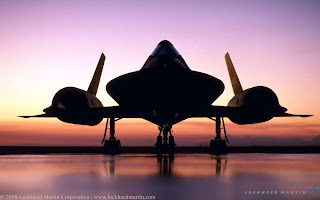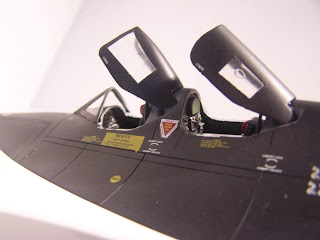 |
| SR71 Blackbird |
SR71 Blackbird was an advanced, long-range, Mach 3+ strategic reconnaissance aircraft. It was developed as a black project from the Lockheed A-12 reconnaissance aircraft in the 1960s by the Lockheed Skunk Works. Clarence "Kelly" Johnson was responsible for many of the design's innovative concepts.SR-71 was designed as a high-speed high altitude aircraft, providing pre-attack and post-attack reconnaissance. If a surface-to-air missile launch was detected, the standard evasive action was simply to accelerate and outfly the missile.
 |
| SR71 Blackbirds |
Constructed of 93% titanium alloy and composites, it produces original stealth technology. A special paint is applied giving it a higher thermal emissivity when cruising at high Mach and contains tiny iron balls that dissipates electromagnetic radiation. The paint alone adds over 60 lbs to the jet.
SR71 Blackbird served with the U.S. Air Force from 1964 to 1998. Of the 32 aircraft built, 12 were lost in accidents, though none to enemy action. SR71 Blackbird has been given several nicknames, including Blackbird and Habu, the latter in reference to an Okinawan species of pit viper. Since 1976, it has held the world record for the fastest air-breathing manned aircraft, a record previously held by the YF-12.
 |
| SR71 Blackbird |
SR71 Blackbird uses a special JP-7 high-temperature jet fuel. It can carry 12,219 gallons and, at top speed, needs refueling every two hours . It consumes fuel at about 5000 gallons per hour. The fuel is very stable and doesn't burn easily which requires a chemical ignition system to start the engines. Tri-ethyl borane (TEB) is injected into the engines at start-up, re-start and when going into afterburner. The fuel system is also used to cool the aircraft environmental, hydraulic, oil, TEB systems, and associated lines. It seeps fuel on the ground and in the air until aircraft heating expansion seals off some of the leaks. Because of an average aircraft temperature at cruise of 600 F, rubber bladders could not be used in the fuel tanks. Tanks were built as tight as possible and silicon was used to seal the seams. Aircraft heating would cause the silicon to become brittle and leak. Every 100 flight hours the tanks had to be opened, the old silicon stripped out, and the new silicon applied.
 |
| SR71 Blackbird |
SR71 Blackbird has 6 main BF Goodrich 22-ply rating tires, each filled with 425 PSI of nitrogen. Impregnated with aluminum powder to reduce heat, they cost $2,300.00 each and are serviceable for approximately 15 landings.
 |
| SR71 Blackbird Kockpit |
SR71 Blackbird featured chines, a pair of sharp edges leading aft from either side of the nose along the fuselage. These were not a feature on the early A-3 design; Dr. Frank Rodgers, of the Scientific Engineering Institute (a CIA front company), had discovered that a cross-section of a sphere had a greatly reduced radar reflection, and adapted a cylindrical-shaped fuselage by stretching out the sides of the fuselage. After the advisory panel provisionally selected Convair's FISH design over the A-3 on the basis of RCS, Lockheed adopted chines for its A-4 through A-6 designs. When the Blackbird was being designed, no other airplane had featured chines, and Lockheed's engineers had to solve problems related to the differences in stability and balance caused by these unusual surfaces.[citation needed] Chines remain an important design feature of many of the newest stealth UAVs, such as the Dark Star, Bird of Prey, X-45 and X-47, since they allow for tail-less stability as well as for stealth.
Spesifications:
- Role: Strategic reconnaissance aircraft
- Manufacturer: Lockheed Skunk Works
- Designer: Clarence "Kelly" Johnson
- Primary users: United States Air Force
- Wingspan: 55.7 ft
- Length: 107.5 ft
- Height: 18.6 ft
- Engines: Two Pratt & Whitney J58 continuous after-burning turbojets with 34,000 lb maximum thrust each
- Publicized Max. Speed: 3.2 mach (2,200 mph)
- Take-off speed: 210 knots
- Landing speed: 150-155 knots. Uses a drag chute to stop.
- Service Ceiling: 85,000 ft plus
- Max. Range: 2,982 miles un-refueled (has flown 18,000 mile missions with in-flight refueling)
- Weight: 145,000 lb max weight
- Crew: 2
- Cost: $24.616 million in 1972















0 comments:
Post a Comment